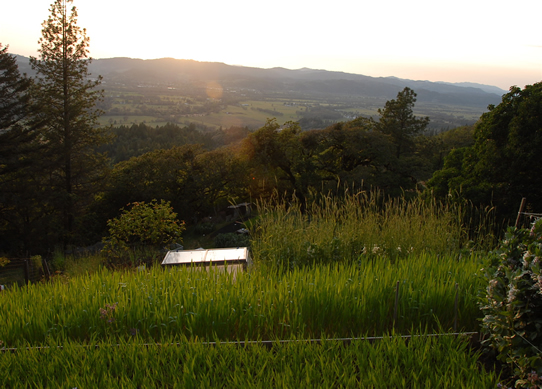Garden Report:
Pine Mountain, the host of Ecology Action’s headquarters, has been standing its ground for millions of years. The Ecology Action Headquarters (EAH) garden has been here for over thirty years. I first arrived about a year and a half ago, so it is with a respectful humility that I approach my new responsibilities, ready to absorb what I can from the mountain and the garden and those who have come before me! Many of the plants and trees we grow have been bred to perform in certain ways. Through this process, they have become dependent on our involvement for their propagation and growth, but we are completely dependent on these plants for our survival as well. This past January, some of us took part in a pruning workshop put on by local fruit tree experts. An example of an unfortunate apple tree was presented to us. Surely someone had good intentions: they bought the tree, planted it in a thoughtful location, but then “life happened” and the tree was totally neglected. After several years of unchecked, unguided growth, its branches grew so top-heavy that they peeled right off the trunk. One might react to this in a number of ways: “What an irresponsible person!” or “What a terrible variety of apple!” But I was deeply persuaded by this scenario to take very seriously the interdependent relationship we have with the plants and trees in our gardens. One thing that we can learn from the garden is the importance of consciously and patiently observing what our plants and trees are telling us, and thoughtfully reacting from a holistic perspective. A good doctor not only topically treats the rash on a patient’s arm but also examines the heart that pumps blood to that rash, and the liver that cleans that blood, and maybe even the brain that controls those organs. A good humanitarian not only considers the nutritional needs of a community, but understands that the social, spiritual, and economic needs must be addressed, too. And a good farmer doesn’t react too quickly to an infection that afflicts her crop with a special spray or “cure”, but views her land as a whole system, and considers general soil health, insect habitat, compost quality and many other components that might have contributed to the crop’s inability to fight off the disease. A highlight of the winter season was the Mondays when some of us came together for apprentice classes. There are several of us, some on staff, some full-time apprentices, who are working our way through the apprentice responsibilities. Preparing and teaching classes on a variety of topics is one of the main requirements. This challenges us to really hone in on the chosen topic through personal research in the EA library—including all of the garden data collected over the years— and then discovering how to best share what we’ve learned. Some classes have covered the historical, philosophical, and scientific background of different elements of the GROW BIOINTENSIVE method, as well as instructions for the practical application of these things and how they connect to different parts of the system. Crop studies have been taught on barley, wheat, rye, amaranth, beans, salsify, sweet potato, Jerusalem artichoke, cabbage, and tree collards. These studies cover the chosen crop’s history, growth habits, water efficiency, culinary and nutritional value, and role in a GROW BIOINTENSIVE system in terms of calorie and biomass production. These classes and the discussions that they trigger often turned into several hours in the large yurt, gathered near the fire, sharing meals and tea as well as our knowledge, creativity, and passion. Truly a source of warmth in those chilly winter months! In future Garden Reports, we’ll see how all these things affect what happens in the Ecology Action Mini-Farm this season and in years to come!
top | Newsletter Home | Article Index | Archive
|



